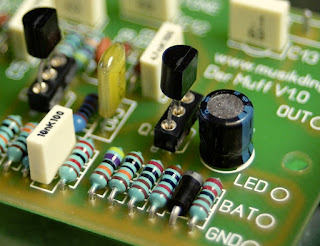 |
| Das Musikding Das Plus overdive kit |
There are a lot of ready to solder kits out there.
I made several from the German web store Das Musikding.
They are well documented and the store also offers all necessary electronic components for DIY guitar pedals, and more. So it's easy to order not only your kit, but your enclosure, knobs, switch and other parts. Banzai Music is another of such site.
 | ||
| Assembled Der Muff kit |
On the first kits i got, holes were not metallised. It means the metal of the solder pads is located to one side only and doesn't extend to the other side of the PCB, via the hole. Solder tends to stay on one side to the PCB and if you heat the pad long enough it might peel off. With metallised holes, the solder easily go upwards to the other side. Your solder is then neat and easy.
 |
| The arrow indicate a burnt solder joint. Solder pad literally peeled off. Fortunately the pin of the IC was not used. |
Nowadays, the latest versions of the kits I received offer a PCB of higher quality. The form factor helps the integration on smaller enclosures. Holes are now metallised. They are a breeze to make.
 |
| PCB of Das Musikding The Angel chorus kit v2 |
And in case you'd like to learn about it, here is my favourite way to cable a 3PDT footswitch.
 | ||
| My favourite way to cable a 3PDT footswitch |




